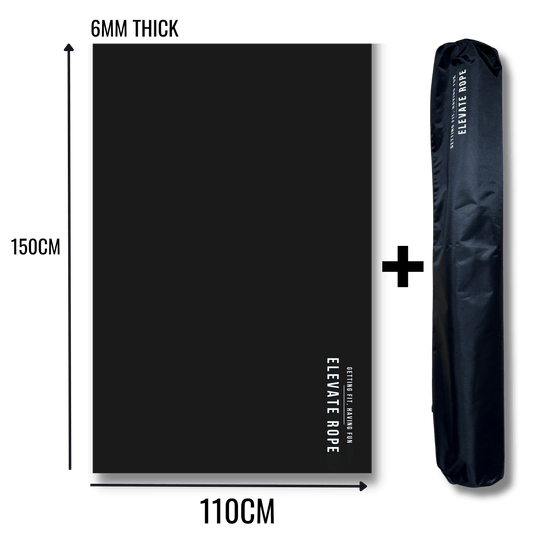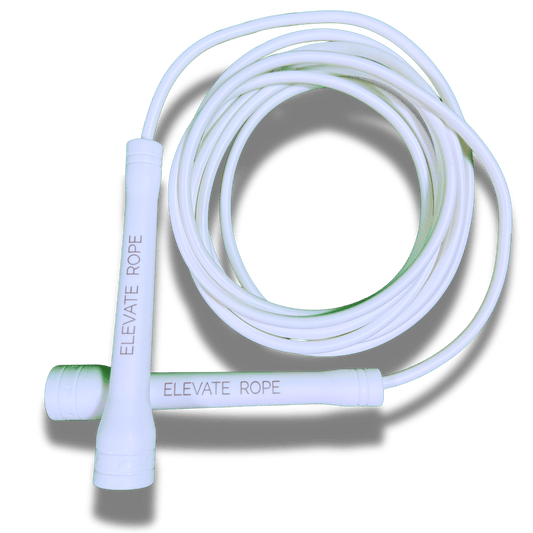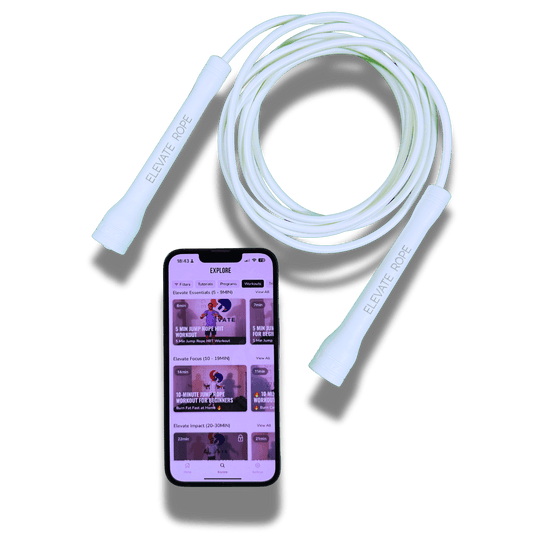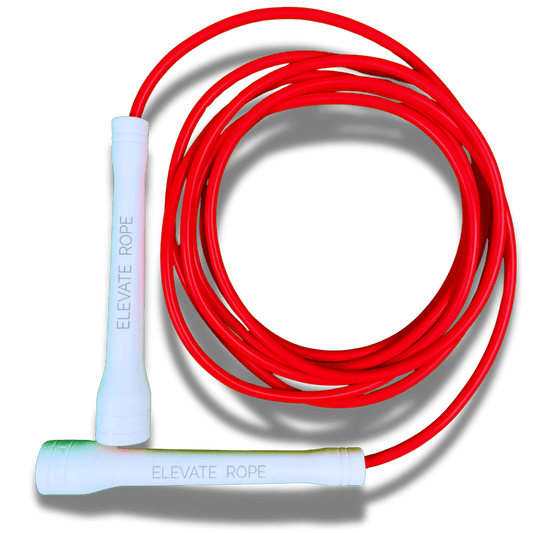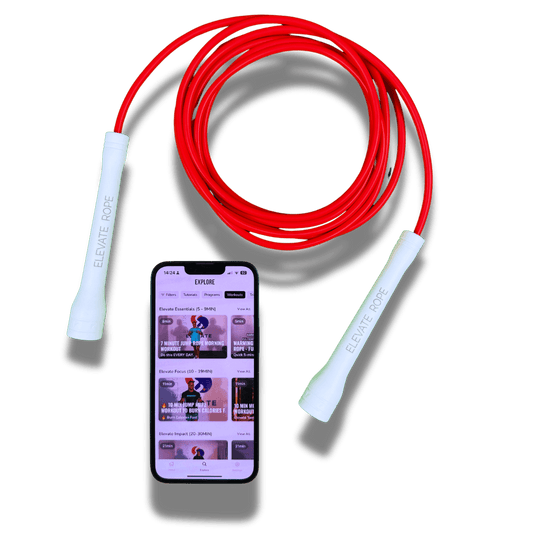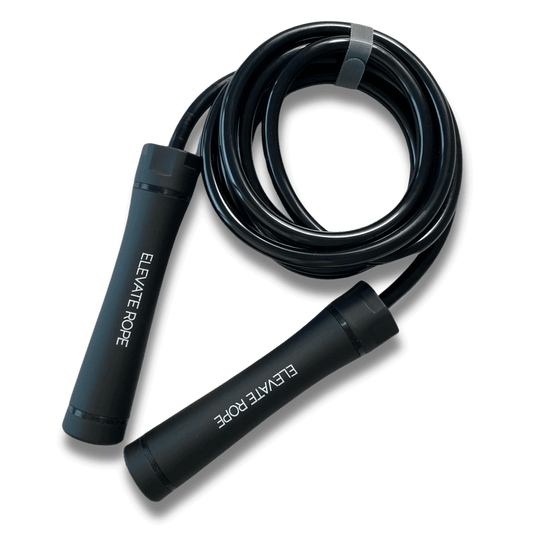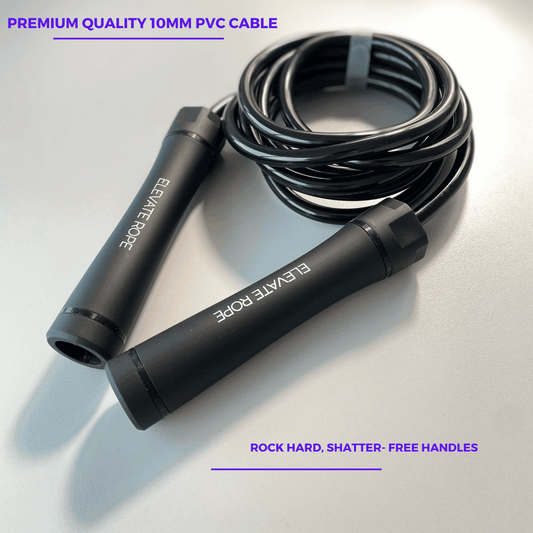Saltare la corda è uno degli allenamenti più efficaci per la forma cardiovascolare, la coordinazione e il condizionamento completo del corpo. Ma come qualsiasi attività ad alto impatto e ripetitiva, può anche mettere sotto stress articolazioni, muscoli e tendini — specialmente se ti alleni intensamente, salti la tecnica o ti alleni mentre devi trattare infortuni con la corda per saltare.
Che si tratti di periostite da battitura sul pavimento, di un fastidio ostinato al tendine d'Achille o di una distorsione alla caviglia per un passo falso, gli infortuni possono mettere in pausa i tuoi progressi e compromettere la tua motivazione. La buona notizia? La maggior parte degli infortuni con la corda per saltare non solo è trattabile ma anche prevenibile con l'approccio giusto.
In questa guida completa, analizzeremo i più comuni infortuni con la corda per saltare, spiegheremo come trattarli efficacemente e ti forniremo una chiara tabella di marcia per tornare a saltare in sicurezza. Imparerai anche quando riposare, quando fare allenamento incrociato e quando è il momento di cercare aiuto professionale.
Questa è la tua risorsa di riferimento per il recupero dagli infortuni da salto con la corda — che tu sia un principiante che affronta il primo ostacolo o un saltatore esperto che mira a tornare al massimo della forma.
Facciamo in modo che tu guarisca, diventi forte e sia pronto a saltare di nuovo — senza paura di reinfortuni.
Comprendere gli infortuni con la corda per saltare
Prima di poter trattare un infortunio con la corda per saltare, devi capire perché accade. Saltare la corda è un movimento dinamico e completo che combina impatti ripetitivi con coordinazione, velocità e resistenza muscolare. Quando l'equilibrio tra carico e recupero si sposta nella direzione sbagliata — o quando la forma, l'attrezzatura o le superfici lavorano contro di te — il rischio di infortunio aumenta rapidamente.
Perché avvengono gli infortuni con la corda per saltare
La maggior parte degli infortuni rientra in una di due categorie:
- Infortuni da sovraccarico – Causati da stress ripetitivo senza sufficiente riposo. Si sviluppano gradualmente e sono comuni nei principianti che aumentano troppo rapidamente il volume di allenamento, o negli atleti esperti che spingono oltre la fatica.
- Infortuni da impatto – Scatenati da una forza improvvisa o da un movimento goffo, spesso dovuti a superfici irregolari, scivolamenti o passi falsi.
Altri fattori che contribuiscono includono:
- Tecnica scorretta – Atterrare troppo pesantemente, saltare troppo in alto o movimenti eccessivi delle braccia.
- Riscaldamento insufficiente – Iniziare "a freddo" senza preparare articolazioni e muscoli.
- Calzature non di supporto – Scarpe senza ammortizzazione o stabilità.
- Scelta della superficie – Terreno duro e implacabile o pavimenti scivolosi.
Tipi comuni di infortuni con la corda per saltare
Infortuni da sovraccarico
- Sindrome da stress tibiale mediale (shin splints) – Dolore lungo la parte anteriore o interna della tibia dovuto a impatti ripetuti.
- Tendinite rotulea (ginocchio del saltatore) – Dolore sotto la rotula causato da stress sul tendine rotuleo.
- Tendinite di Achille – Rigidità o dolore nella parte posteriore della caviglia dovuto a infiammazione del tendine.
Infortuni da impatto
- Distorsioni alla caviglia – Lesione ai legamenti dovuta a torsione o rotazione della caviglia.
- Fratture da stress – Piccole crepe nell'osso causate da carico ripetuto.
Perché è importante comprendere
Sapere che tipo di infortunio si ha aiuta a scegliere la strategia di trattamento giusta. Gli infortuni da sovraccarico di solito richiedono di ridurre il carico, migliorare la mobilità e rafforzare i muscoli di supporto. Gli infortuni da impatto spesso necessitano di immobilizzazione, riabilitazione mirata e un piano di ritorno alla corda più cauto.
Comprendere la causa principale è il primo passo per guarire più velocemente e prevenire che lo stesso problema si ripresenti.
Tipi comuni di infortuni da corda per saltare e come trattarli
Sebbene ogni infortunio sia unico, la maggior parte dei problemi legati alla corda per saltare rientra in alcune categorie prevedibili. Di seguito troverai i tipi più comuni, come riconoscerli e i passaggi per trattarli efficacemente.
A. Infortuni da sovraccarico
1. Sindrome da stress tibiale mediale (Shin Splints)
- Sintomi: Dolore sordo o acuto lungo la tibia, sensibilità alla pressione sull'osso o sul muscolo, fastidio che peggiora con il salto.
- Trattamento:Riposo e riduzione dell'impatto per almeno 1–2 settimane. Applica ghiaccio per 15–20 minuti, 2–3 volte al giorno. Allunga i polpacci e rinforza le gambe inferiori. Passa a superfici più morbide o usa un tappetino per la corda.
- Riposo e riduzione dell'impatto per almeno 1–2 settimane.
- Applica ghiaccio per 15–20 minuti, 2–3 volte al giorno.
- Allunga i polpacci e rinforza le gambe inferiori.
- Passa a superfici più morbide o usa un tappetino per la corda.
- Tempo di recupero: 2–6 settimane.
2. Tendinite rotulea (ginocchio del saltatore)
- Sintomi: Dolore appena sotto la rotula, rigidità quando si sta in piedi dopo essere stati seduti, sensibilità alla pressione del tendine.
- Trattamento:Riduci il volume dei salti; evita piegamenti profondi delle ginocchia. Esegui esercizi eccentrici per i quadricipiti (discese lente). Usa una fascia rotulea per supporto durante attività leggere.
- Riduci il volume dei salti; evita piegamenti profondi delle ginocchia.
- Esegui esercizi eccentrici per i quadricipiti (discese lente).
- Usa una fascia rotulea per supporto durante attività leggere.
- Tempi di recupero: 4–8 settimane.
3. Tendinite di Achille
- Sintomi: Rigidità mattutina o dolore nella parte posteriore della caviglia, gonfiore intorno al tendine.
- Trattamento:Riposa da movimenti ad alto impatto. Esegui stretching del polpaccio e calci eccentrici sul tallone. Indossa scarpe di supporto o usa rialzi per il tallone temporaneamente.
- Riposa da movimenti ad alto impatto.
- Esegui stretching del polpaccio e calci eccentrici sul tallone.
- Indossa scarpe di supporto o usa rialzi per il tallone temporaneamente.
- Tempi di recupero: 4–12 settimane.
B. Lesioni da impatto
4. Distorsioni alla caviglia
- Sintomi: Dolore improvviso, gonfiore, lividi, instabilità durante la camminata.
- Trattamento:Protocollo RICE (riposo, ghiaccio, compressione, elevazione) nelle prime 48 ore. Inizia esercizi delicati di mobilità articolare man mano che il dolore diminuisce. Passa agli esercizi di equilibrio e forza.
- Protocollo RICE (riposo, ghiaccio, compressione, elevazione) nelle prime 48 ore.
- Inizia esercizi delicati di mobilità articolare man mano che il dolore diminuisce.
- Passa agli esercizi di equilibrio e forza.
- Tempi di recupero: 1–8 settimane a seconda della gravità.
5. Fratture da stress
- Sintomi: Dolore osseo localizzato che peggiora con l'impatto e migliora con il riposo, possibile gonfiore.
- Trattamento:Riposo completo dal salto e da altre attività ad alto impatto. Consulta un medico e fai esami per confermare la diagnosi. Carico graduale dopo la guarigione, iniziando con esercizi a basso impatto.
- Riposo completo dal salto e da altre attività ad alto impatto.
- Consulta un medico e fai esami per confermare la diagnosi.
- Carico graduale dopo la guarigione, iniziando con esercizi a basso impatto.
- Tempi di recupero: 6–12 settimane o più.
Consiglio professionale: In tutti i casi, il trattamento funziona meglio se combinato con l'indirizzamento della causa principale — tecnica scorretta, lunghezza della corda errata, picchi nel volume di allenamento o scelta della superficie. Risolvere la causa aiuta a prevenire reinfortuni una volta tornati alla corda.
Principi generali di trattamento
Sebbene i dettagli del recupero dipendano dal tipo di infortunio, esistono principi di trattamento fondamentali che si applicano in generale. Questi formano la base di qualsiasi piano di riabilitazione sicuro ed efficace.
1. Segui il protocollo RICE
Riposo, Ghiaccio, Compressione, Elevazione rimane uno dei trattamenti di primo intervento più efficaci per lesioni acute.
- Riposo: Riduci o interrompi l'attività ad alto impatto per permettere la guarigione.
- Ghiaccio: Applica per 15–20 minuti ogni 2–3 ore nelle prime 48 ore per ridurre gonfiore e dolore.
- Compressione: Usa una benda elastica o una manica compressiva per controllare il gonfiore.
- Elevazione: Mantieni l'area infortunata sopra il livello del cuore quando possibile.
2. Modifica il tuo carico di allenamento
Continuare a saltare a pieno volume mentre si è infortunati ritarda il recupero. Invece:
- Accorcia le sessioni o riduci la frequenza.
- Passa a esercizi a basso impatto o cardio alternativi.
- Monitora i livelli di dolore e progredisci solo quando il disagio diminuisce.
3. Usa il Cross-Training per Mantenere la Forma
Le attività a basso impatto mantengono attivo il sistema cardiovascolare senza aggravare l'infortunio:
- Nuoto
- Ciclismo
- Macchina ellittica
- Allenamento di resistenza (evitando stress sull'area infortunata)
- Salta la corda con una corda più facile
4. Integra il Lavoro di Mobilità nella Riabilitazione
Esercizi di mobilità delicati mantengono l'ampiezza di movimento articolare e prevengono la rigidità durante il recupero. Concentrati su movimenti controllati e senza dolore che coinvolgano l'area interessata e le articolazioni circostanti.
5. Monitora Dolore e Progresso
- Usa una semplice scala del dolore da 0 a 10 durante e dopo l'esercizio.
- Dolore sopra 3/10 durante la riabilitazione, l'attività è un segnale per ridurre l'intensità.
- Monitora settimanalmente gonfiore, mobilità e forza.
In sintesi: Un recupero efficace è un equilibrio tra proteggere l'infortunio e mantenere il resto del corpo forte e mobile. Con questi principi, sarai pronto a passare a un piano sicuro di ritorno alla corda.

Quando Consultare un Professionista
Mentre molte lievi lesioni da salto con la corda possono essere gestite con riposo, esercizi di mobilità e aggiustamenti del carico, alcune situazioni richiedono una valutazione esperta. Ignorare questi segnali può portare a problemi cronici, tempi di recupero più lunghi o complicazioni più gravi.
Sintomi di Allarme
Cerca immediatamente assistenza professionale se sperimenti:
- Incapacità di caricare peso sull'arto infortunato
- Gonfiore grave o lividi che compaiono entro poche ore
- Intorpidimento, formicolio o perdita di sensibilità
- Dolore acuto e lancinante che non si allevia con il riposo
- Dolore che peggiora in 7–10 giorni nonostante l'autocura
- Deformità visibile o disallineamento articolare
Tipi di professionisti da consultare
- Fisioterapista – Crea programmi di riabilitazione mirati per ripristinare mobilità, forza e funzionalità.
- Medico dello sport – Diagnostica gli infortuni, prescrive esami e guida i tempi di ritorno allo sport.
- Specialista ortopedico – Tratta infortuni gravi o strutturali, come lesioni ai legamenti o fratture.
Perché l'intervento precoce è importante
- Previene che piccoli infortuni si trasformino in problemi a lungo termine.
- Riduce i tempi di recupero identificando precocemente il trattamento più efficace.
- Fornisce un piano chiaro e sicuro per tornare a saltare la corda senza ricadute.
Consiglio professionale: Se non sei sicuro se il tuo infortunio necessita di attenzione medica, meglio essere cauti. Un appuntamento ora può evitarti settimane o mesi di frustrazione in seguito.
Ritorno alla corda dopo un infortunio
Un piano intelligente per tornare alla corda è importante quanto il trattamento stesso. Tornare troppo presto rischia di vanificare settimane di guarigione. Procedi passo dopo passo, ascolta il tuo corpo e ricostruisci la tua fiducia insieme alla tua forma fisica.
Passo 1: Movimento quotidiano senza dolore
Prima di prendere la corda, assicurati di poter camminare, salire le scale e svolgere le attività quotidiane senza dolore o gonfiore. Questa base garantisce che il tuo infortunio sia sufficientemente guarito per un impatto controllato.
Passo 2: Esercizi con la corda a basso impatto
Inizia con movimenti che ti mantengano attivo senza stressare l'infortunio:
- Oscillazioni laterali – La corda si muove da un lato all'altro senza saltare. (ideale da abbinare a una speed rope)
- Shadow skipping – Imita il movimento della corda senza corda per esercitarti su ritmo e postura.
Fai 1–2 minuti, riposa, poi ripeti per 2–3 serie.
Passo 3: Sessioni di salto brevi e a bassa intensità
Una volta che riesci a gestire esercizi leggeri senza dolore, introduci i salti veri e propri:
- 2–3 minuti di rimbalzo base a bassa altezza (2–3 cm da terra).
- Concentrati su atterraggi morbidi a metà piede e su un controllo fluido della corda.
Passo 4: Aumento graduale del volume
Usa la regola del 10% — aumenta il tempo totale o le rotazioni di non più del 10% a settimana.
Alterna i giorni di salto con il recupero attivo (lavoro di mobilità, ciclismo o stretching).
Passo 5: Prima la tecnica, poi i trucchi
Perfeziona la tua forma prima di aggiungere velocità, double unders o movimenti complessi dei piedi. La tecnica corretta è la tua polizza assicurativa contro le recidive.
Consiglio professionale: Tieni un diario dei recuperi per monitorare durata, intensità e come ti senti dopo ogni sessione. Piccoli miglioramenti nel corso delle settimane sono molto meglio di grandi salti seguiti da ricadute.
Prevenzione degli infortuni a lungo termine
Una volta recuperato da un infortunio, il tuo obiettivo successivo è assicurarti che non si ripeta. La prevenzione riguarda la costruzione della resilienza, il perfezionamento della tecnica e la creazione di un ambiente di allenamento in cui il tuo corpo possa prosperare a lungo termine.
1. Riscaldamento e mobilità ad ogni sessione

- Dedica 5–8 minuti alla mobilità dinamica prima di saltare.
- Includi circonduzioni delle caviglie, sollevamenti dei polpacci, aperture delle anche, rotazioni delle spalle e rotazioni dei polsi.
- Questo prepara le tue articolazioni, i muscoli e il sistema nervoso a un movimento efficiente.
2. Rafforza i gruppi muscolari chiave
Muscoli più forti assorbono maggiormente l'impatto e proteggono le articolazioni.
- Polpacci e caviglie: sollevamenti sui polpacci, salti su una gamba.
- Quadricipiti e glutei: squat, affondi, ponte per glutei.
- Core: plank, dead bug, plank laterali per la stabilità.
3. Rispetta i giorni di recupero
- Programma 1–2 giorni di riposo a settimana dal salto con la corda.
- Usa il recupero attivo (camminata, stretching leggero, nuoto) per favorire la circolazione.
- Punta a 7–9 ore di sonno per notte per una riparazione ottimale.
4. Scegli la superficie e le calzature giuste
- Opta per pavimenti ammortizzanti (legno, campi sportivi) o un tappetino di qualità per salto con la corda.
- Indossa scarpe di supporto, ammortizzate e progettate per allenamenti ad alto impatto.
- Sostituisci le scarpe usurate ogni 300–500 km di utilizzo.
5. Progredisci gradualmente
- Segui la regola del 10% per aumentare volume o intensità.
- Alterna tra lavoro sulle abilità, sessioni di velocità e di resistenza per evitare stress ripetitivi.
In sintesi: La prevenzione degli infortuni non riguarda solo evitare il dolore — riguarda creare le condizioni per un progresso costante e sostenibile. Un corpo sano è il miglior potenziatore di prestazioni.
Conclusione
Gli infortuni da salto con la corda possono essere frustranti, ma non devono essere la fine della carriera — né tantomeno della passione. Con il piano di trattamento giusto, un ritorno graduale all'allenamento e strategie di prevenzione intelligenti, puoi tornare più forte di prima.
La chiave è ascoltare il tuo corpo, affrontare i problemi precocemente ed evitare la tentazione di affrettare il recupero. Ogni sessione in cui ti alleni senza dolore è una vittoria che costruisce costanza, fiducia e prestazioni a lungo termine.
Comprendendo i tipi comuni di infortuni da salto con la corda, sapendo come trattarli e impegnandoti in mobilità, forza e recupero, ti stai preparando per anni di salto sicuro e piacevole.
Ora tocca a te. Applica i passaggi di questa guida, sii paziente con il processo e fai della prevenzione degli infortuni parte del tuo allenamento — non un ripensamento.
Pronto a saltare di nuovo senza paura? Prendi la tua [Elevate Rope], inizia con intelligenza e torna a muoverti al meglio.
